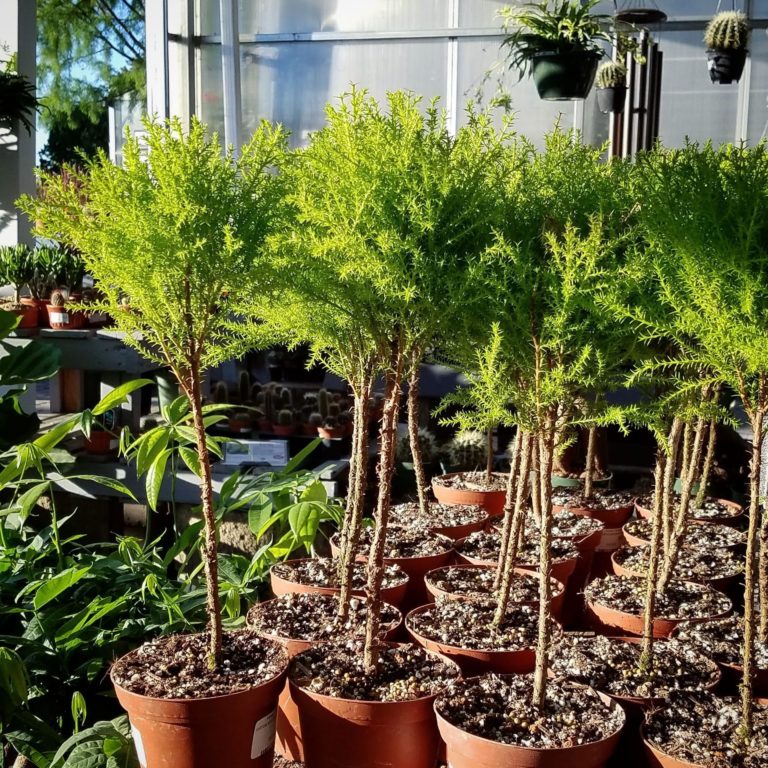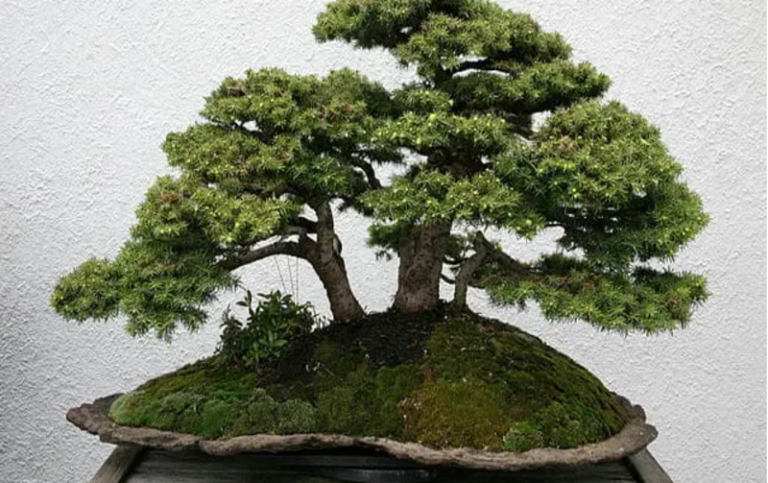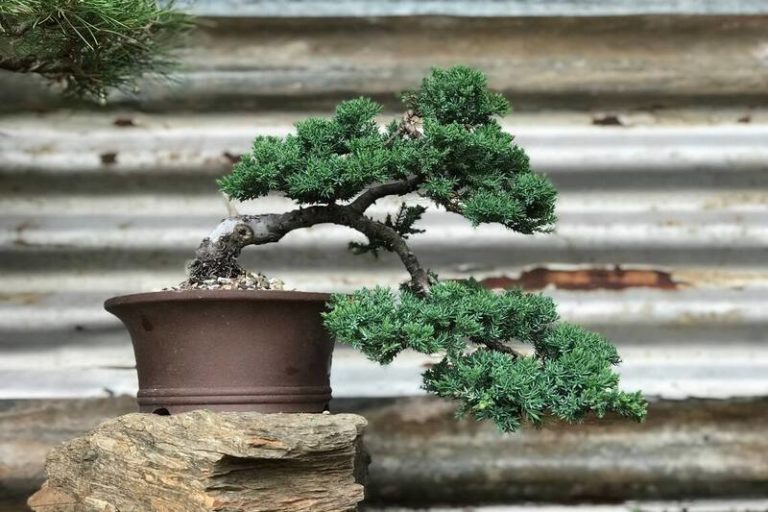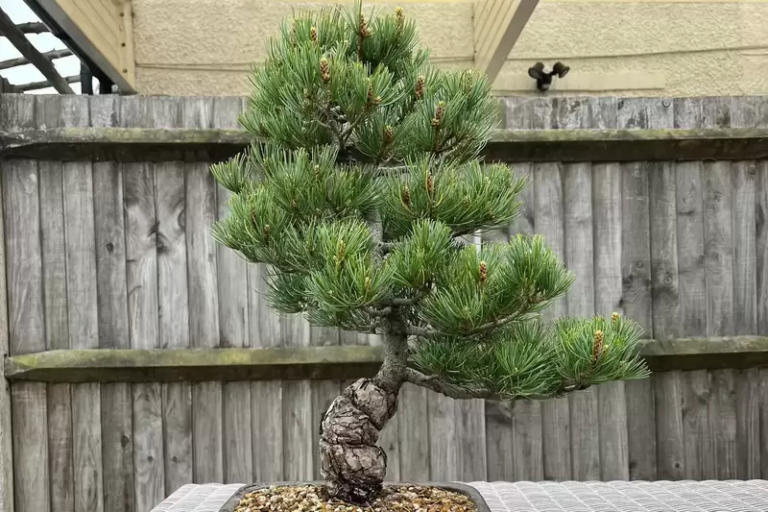Bonsai Japanese Black Pine : The Art of Cultivating a Miniature Masterpiece
Bonsai is a popular recreation involving the cultivation of miniature trees in containers. The Japanese black pine, a tree indigenous to Japan that has been cultivated for millennia, is one of the most popular options for bonsai.
The Japanese black pine is a hardy tree that is known for its striking appearance. It has long, dark green needles and produces large, decorative cones. The bark of the tree is rough and textured, adding to its visual appeal.
What is Bonsai Japanese Black Pine?
Bonsai The Japanese black pine that is cultivated in bonsai pots is a miniature replica of the Japanese black pine tree. It is favored by bonsai enthusiasts because of its remarkable appearance, resilience, and simplicity of care. The cultivation of a bonsai Japanese black pine necessitates the application of specific techniques, such as regular pruning and decorating, adequate irrigation and fertilization. It can be a beautiful and rewarding addition to any home or garden with appropriate maintenance.
Types of Bonsai Japanese Black Pine
There are several types of Bonsai Japanese Black Pine, each with their own unique characteristics and styles. Here are some of the most popular types:
1.‘Thunderhead’- This cultivar is known for its thick, fluffy needles and bushy appearance.
2. ‘Mikawa’- This cultivar is known for its upright growth habit and dark green needles.
3. ‘Kotobuki’- This cultivar is known for its twisted and contorted branches, which give it a unique appearance.
4. ‘Goyomatsu’- This cultivar is known for its short needles and small, compact growth habit.
5. ‘Zuisho’- This cultivar is known for its dense foliage and bright green needles.
No matter which variety of Bonsai Japanese Black Pine you select, it is essential to care for and maintain it properly to ensure its long-term health and attractiveness.
This includes routine pruning, contouring, and irrigation, as well as fertilization and pest and disease protection. A Japanese Black Pine Bonsai can be a beautiful and rewarding addition to any home or garden if cared for properly.
Bonsai Japanese Black Pine and Its Symbolism
Not only is the Japanese Black Pine bonsai a stunning plant, but it also has great cultural significance in Japan. The pine tree is a symbol of fortitude, resilience, and longevity in Japanese culture. The Japanese Black Pine Bonsai is a diminutive replica of this mighty tree, making it a popular symbol among bonsai enthusiasts.
In Japanese culture, the diminutive scale of the bonsai Japanese Black Pine also symbolizes restraint and simplicity. Growing and shaping a bonsai tree requires a great deal of patience and attention to detail, which reflects the Japanese cultural values of discipline and concentration.
The Bonsai Japanese Black Pine has symbolic value in the art of bonsai, in addition to its cultural relevance. The act of shaping and pruning a bonsai tree is a type of art that needs the artist to carefully examine every element, from branch location to leaf shape. This attention to detail, as well as the tree’s purposeful sculpting, reflect the beauty and harmony that may be attained in all parts of life via balance and proportion.
Overall, the Bonsai Japanese Black Pine represents the virtues of strength, tenacity, simplicity, and beauty in Japan, and has great cultural and symbolic resonance. It is a popular option among bonsai aficionados as a reminder of the need of patience, discipline, and attention to detail in establishing harmony and balance in life.

Characteristics of Bonsai Japanese Black Pine
Because of its distinct and eye-catching characteristics, the Bonsai Japanese Black Pine is a favorite option among bonsai enthusiasts. These are some of its distinguishing features:
- Needle-like leaves: The Bonsai Japanese Black Pine has long, needle-like leaves that are dark green in color. The needles are arranged in clusters of two, three, or five and can grow up to 5 inches in length.
- Rough bark: The bark of the Bonsai Japanese Black Pine is rough and textured, with deep fissures and grooves that add to its visual appeal.
- Compact size: The Bonsai Japanese Black Pine is planted in small pots as a bonsai tree and is trimmed and sculpted to retain its compact size. This makes it an excellent alternative for individuals who have limited space or wish to grow a tree inside.
- Hardy and resilient: The Bonsai Japanese Black Pine is a very sturdy and adaptable tree, thriving in full sun, moderate shade, and even areas with high wind and salt concentrations.
- Unique styling: Because of how it grows and what it looks like on its own, the Bonsai Japanese Black Pine can be styled in many different ways, from straight and formal to twisted and twisted. This gives the person who trims and shapes the tree a lot of room for creativity and artistic expression.
The Japanese Black Pine is a popular option among bonsai lovers since it is an unique and pleasing to the eye tree with a variety of features. It may be dressed in an unique way and is tough and tiny. It is hence a flexible and simple-to-care-for plant.
How to Grow Bonsai Japanese Black Pine
Cultivating a Japanese Black Pine bonsai requires specific techniques and meticulous care. Here are some instructions for cultivating this magnificent tree:
Choose a suitable container: The Japanese Black Pine Bonsai should be cultivated in a shallow container with adequate drainage. The container’s dimensions should be proportional to the tree’s size.
Prepare the soil: The soil needs to be easy to drain and full of nutrients. Most of the time, Akadama, pumice, and lava rock are mixed together to make bonsai soil.
Plant the tree: Plant the bonsai Japanese Black Pine in the pot, making sure the roots are equally distributed throughout the soil. Make sure the tree is securely planted by gently pressing the earth down around it.
Water the tree: Regularly water the bonsai Japanese Black Pine, ensuring that the soil is saturated but not soggy. Allow the soil to become marginally dry between watering.
Fertilize the tree: Fertilize the bonsai Japanese Black Pine every two weeks during the growing season (spring to autumn) and once per month during the winter with a balanced fertilizer.
Trim and shape the tree: To maintain the tree’s size and form, it must be pruned and shaped. Remove any deceased, damaged, or unwanted branches with precise pruning shears. Wire the tree’s branches into the intended position in order to shape it.
Repot the tree: The Japanese Black Pine bonsai should be repotted every two to three years, or when it has exceeded its receptacle. Repotting enables for the maintenance of fresh soil and healthy roots.
You can grow and care for a beautiful Bonsai Japanese Black Pine if you follow these steps and pay close attention to what the tree needs.
Benefit of Bonsai Japanese Black Pine
The Japanese Black Pine bonsai has both beauty and symbolic benefits. Some of the reasons why you should plant this stunning tree are as follows:
- Decorative purposes: Bonsai devotees and collectors favor the Bonsai Japanese Black Pine due to its striking appearance and distinct styling potential. It can be used as a decorative element in residences, offices, and gardens, enhancing the attractiveness and sophistication of any space.
- Stress relief: Cultivating and caring for a Japanese Black Pine Bonsai can be a relaxing and tranquil activity. It necessitates patient and attention to detail, which can help alleviate tension and promote mindfulness.
- Air purification: The Japanese Black Pine Bonsai, like other plants, may help clean the air by removing pollutants and releasing oxygen. It is therefore a fantastic option for interior areas, particularly those with low air quality.
- Educational purposes: Cultivating a Japanese Black Pine Bonsai can be an educational experience that teaches individuals about the natural world and the significance of plant maintenance.
- Connection to nature: Even if they reside in an urban or suburban setting, those who cultivate a Japanese Black Pine bonsai can feel more connected to nature. It can also provide a sense of accomplishment and fulfillment as the tree grows and matures.
Ultimately, the Bonsai Japanese Black Pine has multiple benefits, including decorative, stress-relieving, and educational qualities. It is a gorgeous and gratifying plant to cultivate and maintain, offering both aesthetic and utilitarian benefits.
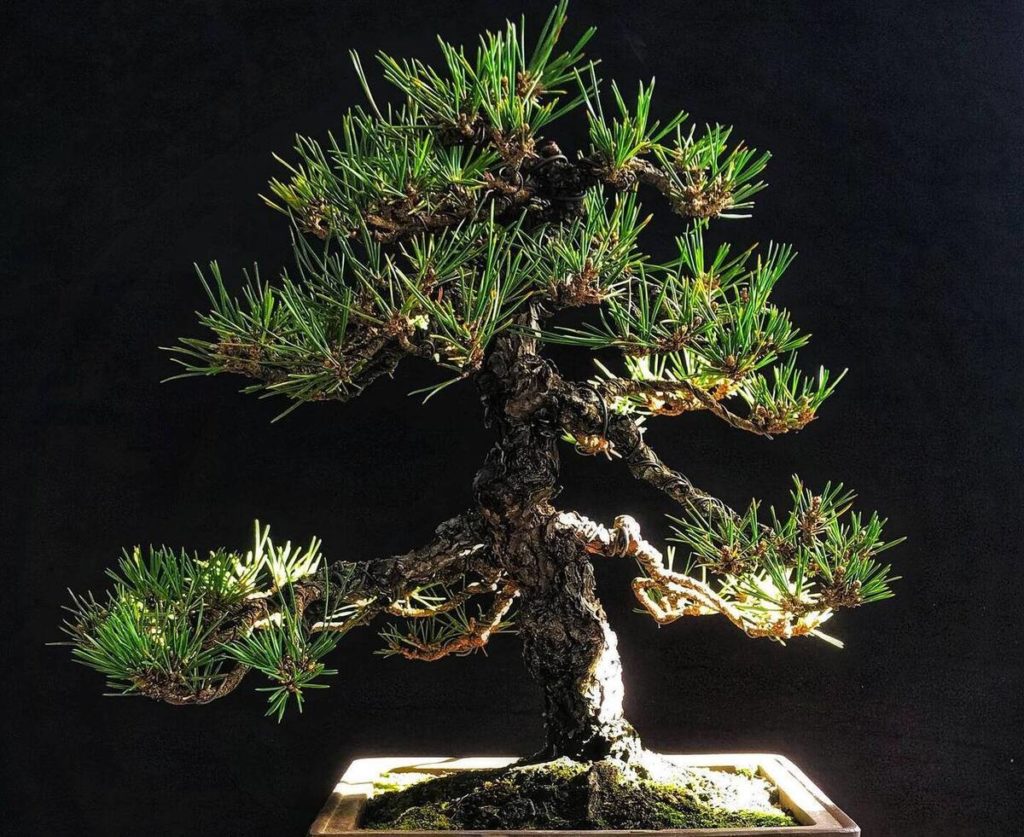
Styling and Design for Bonsai Japanese Black Pine
Bonsai design and styling Creating a Japanese Black Pine requires careful pruning and contouring of the tree. The following are some standard approaches to designing and styling this style of bonsai:
Formal upright style: This style involves making a straight trunk that grows straight up and has branches that are all the same distance apart. It is a popular style for the Bonsai Japanese Black Pine because it naturally grows straight and tall, which works well with this design.
Slanting style: This style has a trunk that leans to one side and branches that grow in the same way on both sides of the tree.
Informal upright style: This technique involves creating a more natural, irregular shape for the tree by bending and winding the trunk and branches in different directions.
Cascade style: In this style, you make a tree whose trunk and branches hang over the edge of the container and cascade down.
Multi-trunk style: In this style, you make a tree with multiple trunks that grow out from a central point. This makes the design more complex and interesting.
The natural growth pattern of a Japanese Black Pine bonsai should be taken into account while styling and designing the tree in order to get a symmetrical and harmonious result. To form the branches and trunk into the desired shape, use pruning shears and wiring procedures.
As the tree matures and expands, you may modify the design. You may make a stunning and one-of-a-kind Bonsai Japanese Black Pine that will be a delight to see for years to come if you have patience and pay close attention to detail.
How to Care and Maintain Bonsai Japanese Black Pine
Caring for and keeping a Bonsai Japanese Black Pine necessitates meticulous attention to detail as well as a dedication to regular maintenance. Here are some pointers to maintain your tree healthy and flourishing:
- Watering: Watering is necessary on a regular basis for bonsai Japanese Black Pines, but be careful not to overwater. Water the tree when the soil seems dry, but don’t allow it go entirely dry. To prevent injuring the fragile roots, use a watering can or hose with a mild stream.
- Fertilizing: To preserve their health and vigor, bonsai Japanese Black Pines require frequent fertilizer. Employ a balanced fertilizer designed particularly for bonsai plants and follow the manufacturer’s directions.
- Pruning: Pruning on a regular basis is vital for keeping your Bonsai Japanese Black Pine in form and health. Remove any dead, damaged, or diseased branches using sharp pruning scissors and shape the tree as desired.
- Repotting: Repotted Bonsai Japanese Black Pines should be done every 2-3 years to ensure proper soil and root health. Select a slightly larger container than the present one and a well-draining soil mix designed particularly for bonsai plants.
- Sunlight and temperature: Japanese Black Pine bonsai trees require ample sunlight to flourish, but should also be shielded from extreme temperatures. Avoid exposing your tree to temperatures below 20 degrees Fahrenheit or above 90 degrees Fahrenheit, as well as direct sunlight.
- Pest and disease control: Maintain an eye out for common pests and diseases, such as spider mites, scale insects, and needle cast disease, that can affect Bonsai Japanese Black Pines. If necessary, apply an insecticide or fungicide designed specifically for bonsai trees.
Bonsai Japanese Black Pine Care Sheet
| Aspect | Care Tips |
| Watering | Water regularly, but don’t overwater. Allow soil to dry between watering. |
| Fertilizing | Fertilize every 2-3 weeks during growing season with balanced fertilizer. |
| Pruning | Regularly prune to maintain shape and promote branching. |
| Repotting | Repot every 2-3 years with well-draining soil mixture. |
| Sunlight | Place in sunny location, protect from extreme temps and winds. |
| Pest and disease | Regularly inspect and treat for common issues such as spider mites and pine needle rust. |
By adhering to these care and maintenance guidelines, you can ensure that your Japanese Black Pine bonsai stays healthy, vibrant, and attractive for many years.
Conclusion
Japanese Black Pine Bonsai is a popular tree among bonsai enthusiasts. It requires consistent irrigation, fertilization, pruning, and repotting. It should be positioned in a sunny area and shielded from extreme temperatures.
In addition, routine vermin and disease control is essential. The Bonsai Japanese Black Pine can be a beautiful and distinct addition to any collection with appropriate maintenance.
FAQ:
Q: What is a Bonsai Japanese Black Pine?
A: It’s a small tree cultivated in a miniature form with black and green needles.
Q: How do you care for a Bonsai Japanese Black Pine?
A: Regular watering, fertilizing, pruning, and repotting are required. It must be placed in a sunny location and protected from extreme temperatures. Pest and disease control measures should be implemented when necessary.
Q: How long does a Bonsai Japanese Black Pine live?
A: With proper care, it can live for many decades or even centuries.
Q: Can I grow a Bonsai Japanese Black Pine indoors?
A: Yes, if there is enough light and moisture. But growing them indoors can make them more likely to get bugs and diseases.
Q: How often should I repot my Bonsai Japanese Black Pine?
A: Every 2-3 years, but the timing may vary depending on the tree’s size, age, and growing conditions.
Also Read:



